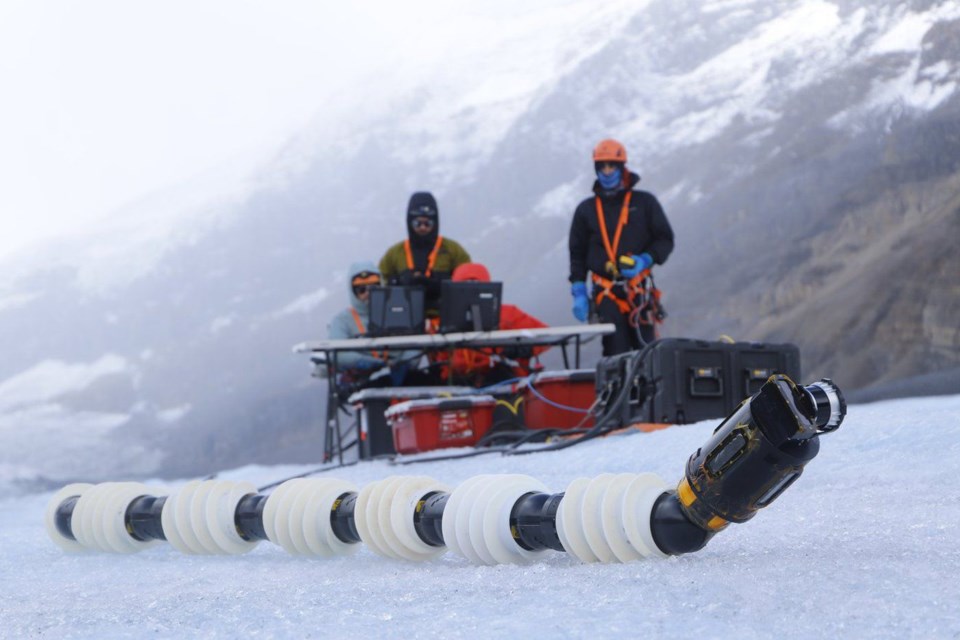NASA recently undertook some field testing in Jasper National Park, although with a rather unique device being tested and in a very special field.
Scientists from the American space agency’s Jet Propulsion Laboratory (JPL) brought EELS with them to Athabasca Glacier in September. The device (whose acronym expands into Exobiology Extant Life Surveyor) is essentially a 4.4-metre long, 200 lb. mechanical snake that is 10 centimetres in diameter.
JPL scientist Dr. Morgan Cable said that EELS is meant to do what exploration rovers (such as those on Mars missions) cannot manage or maneuver around since some slopes are too steep for them.
“They still have some limitations. They are not able to access the hard-to-reach places.”
NASA now recognizes the probability that a microbe will be in small or hidden places, not hanging out on the surface of Mars or Europa or Enceladus, completely exposed to extremes of pressure and temperature.
“EELS is one example of a robotic architecture that's designed to reach those hard to access places and hopefully be able to give us a better, deeper understanding of whether or not there is life in other places in the solar system,” Cable said.
Cable and her team have tested EELS at other locations including their own facility called the Mars Yard, as well as a ski resort closer to their research headquarters in Pasadena, California. They were on site at Athabasca Glacier for a few weeks in the fall to drive EELS around an area that offered them a landscape unlike any other.
For one thing, there are tour buses. Those came in handy for the weighty robot and all of the support equipment that would otherwise have to be packed in.
“The other benefit to Athabasca Glacier is it has a lot of these features that we really wanted to test for icy environments: places like Europa and Enceladus. It has cracks, crevasses in the ice … moulins. They're basically like conduits that tend to go all the way down through the glacier down to the bottom.”
Those moulins are interesting from an earth science perspective, too. Her team took some measurements for earth science colleagues who will be using that information for some upcoming science papers.
“What was enabling for us is having all those features in one place that was accessible,” Cable said.
“We just really loved working with colleagues in that community. We're so excited to be able to adopt us into that earth science cryosphere community as well. It's been a really rewarding experience.”
Cable and her JPL team have been to the glacier in the past with the EELS project, albeit with only the snake head where most of the sensory devices are located. It has a number of imagers as well as LiDAR, a laser 3D mapping device.
This fall was the first time that they brought two EELS prototypes: one that was the full-sized EELS to test for horizontal mobility on the surface and another that was basically a couple of modules. EELS is designed to be expandable, so that the team can add or remove modules as the circumstances require.
This most recent test was a successful one.
“We were very pleased,” Cable said. “We learned a whole lot about how the robot operates in different environments in and around different terrain types. We also collected a lot of science data.”
In addition, they were able to generate a host of LiDAR maps that can be used later for testing autonomy and other things in silico, also known as digital space.
"We also did some measurements with one of those instruments that fits in an EELS module,” Cable said. “We were able to tech detect all sorts of salts that are important for life as we know it while it was submerged in some of these glacial streams and other liquid areas.”
The testing continues, including EELS’ autonomy programming. The possibility exists that NASA will return to Jasper National Park for further research. Or…
“Who knows, you may see a little mini version of EELS on the Moon or Mars,” Cable said. “Who knows what's next? I think this has laid the groundwork for a lot of potential opportunities moving forward."




